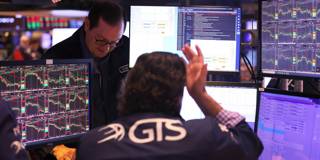In the face of high and persistent inflation, recession risks, and now a looming insolvency crisis in the financial sector, central banks like the US Federal Reserve are facing a trilemma. Unable to fight inflation and provide liquidity support simultaneously, the only solution is a severe recession – and thus a broader debt crisis.
NEW YORK – In January 2022, when yields on US ten-year Treasury bonds were still roughly 1% and those on German Bunds were -0.5%, I warned that inflation would be bad for both stocks and bonds. Higher inflation would lead to higher bond yields, which in turn would hurt stocks as the discount factor for dividends rose. But, at the same time, higher yields on “safe” bonds would imply a fall in their price, too, owing to the inverse relationship between yields and bond prices.
This basic principle – known as “duration risk” – seems to have been lost on many bankers, fixed-income investors, and bank regulators. As rising inflation in 2022 led to higher bond yields, ten-year Treasuries lost more value (-20%) than the S&P 500 (-15%), and anyone with long-duration fixed-income assets denominated in dollars or euros was left holding the bag. The consequences for these investors have been severe. By the end of 2022, US banks’ unrealized losses on securities had reached $620 billion, about 28% of their total capital ($2.2 trillion).
Making matters worse, higher interest rates have reduced the market value of banks’ other assets as well. If you make a ten-year bank loan when long-term interest rates are 1%, and those rates then rise to 3.5%, the true value of that loan (what someone else in the market would pay you for it) will fall. Accounting for this implies that US banks’ unrealized losses actually amount to $1.75 trillion, or 80% of their capital.

NEW YORK – In January 2022, when yields on US ten-year Treasury bonds were still roughly 1% and those on German Bunds were -0.5%, I warned that inflation would be bad for both stocks and bonds. Higher inflation would lead to higher bond yields, which in turn would hurt stocks as the discount factor for dividends rose. But, at the same time, higher yields on “safe” bonds would imply a fall in their price, too, owing to the inverse relationship between yields and bond prices.
This basic principle – known as “duration risk” – seems to have been lost on many bankers, fixed-income investors, and bank regulators. As rising inflation in 2022 led to higher bond yields, ten-year Treasuries lost more value (-20%) than the S&P 500 (-15%), and anyone with long-duration fixed-income assets denominated in dollars or euros was left holding the bag. The consequences for these investors have been severe. By the end of 2022, US banks’ unrealized losses on securities had reached $620 billion, about 28% of their total capital ($2.2 trillion).
Making matters worse, higher interest rates have reduced the market value of banks’ other assets as well. If you make a ten-year bank loan when long-term interest rates are 1%, and those rates then rise to 3.5%, the true value of that loan (what someone else in the market would pay you for it) will fall. Accounting for this implies that US banks’ unrealized losses actually amount to $1.75 trillion, or 80% of their capital.